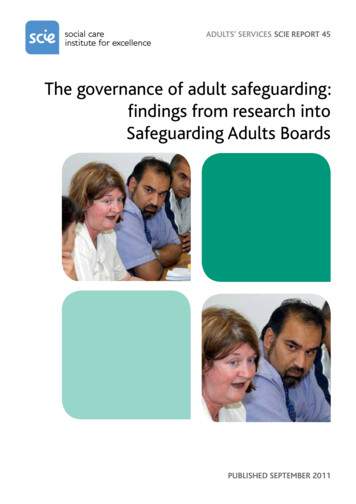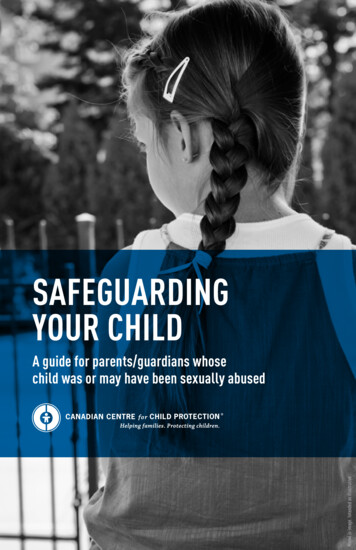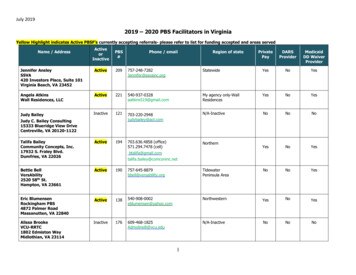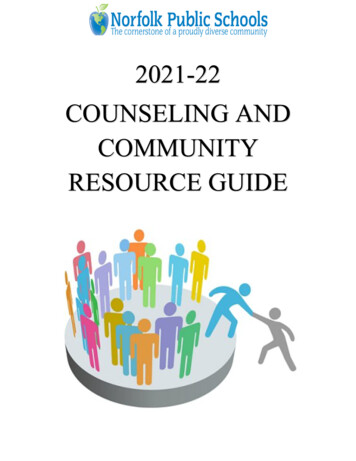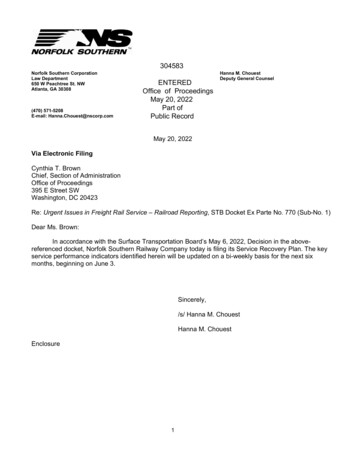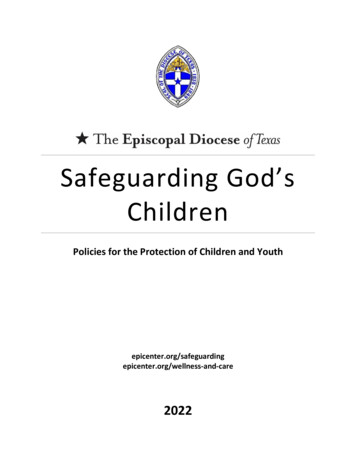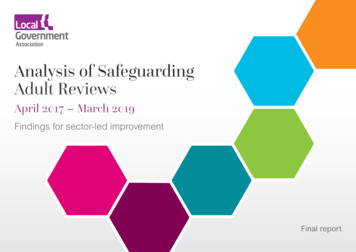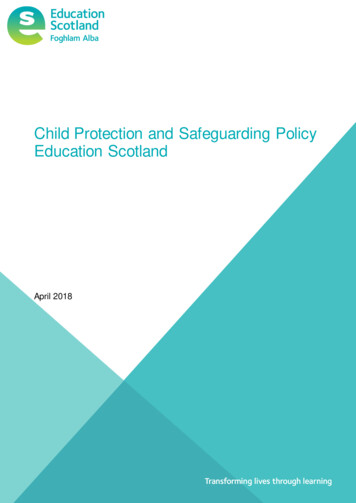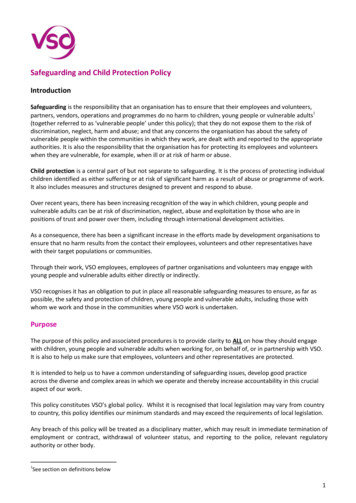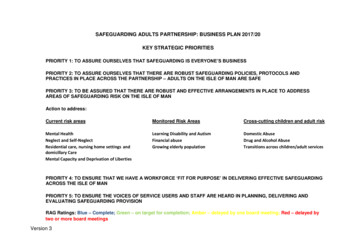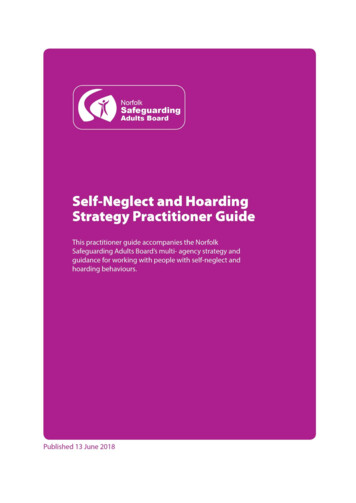
Transcription
Table of contentSection123456789101IntroductionA multi-agency approachClutter Image Rating Tool (CIRT) FlowchartClutter Image Rating Scale - BedroomClutter Image Rating Scale - loungeClutter Image Rating Scale - kitchenAssessment Tool GuidelinesGuidance for practitionersPractitioners hoarding assessmentGuidance questions which could be used during anassessmentMaking Safeguarding Personal (MSP)Hoarding self assessmentPage2245678910121416NSAB Self neglect and hoarding practitioners guide
1.IntroductionThis practitioner guide accompanies the full Norfolk Safeguarding Adult’s Board (NSAB) Strategyand Guidance Document for self-neglect and hoarding developed in the context of duties set out inthe Care Act 2014. It is intended as a toolkit for practitioners from a range of agencies to supportmanagement of cases where an adult is deemed to be at risk due to self-neglecting and/or hoardingbehaviours.The guide supports a multiagency approach focused on early intervention and prevention, makinguse of Early Help Hubs (EHH) as a forum for collaborative casework by practitioners.For full guidance on information sharing, definitions and related legislation please refer to NorfolkSafeguarding Adult’s Board (NSAB) Strategy and Guidance Document for self-neglect andhoarding.2.A multi-agency approachThe NSAB strategy and guidance outlines that responding to individuals with self-neglect/hoarding behaviours must be a multi-agency priority and there is a presumption that: All partner agencies will actively engage when this is requested by the lead agency asappropriate or required; and The agency holding the case, will take responsibility for initiating a multi-agencypartnership working approach within the agreed framework of the full strategy andguidance (via the EHH). All partner agencies will maintain a robust data information system in regard to selfneglect and hoarding, with the aim that this should inform service delivery, justifydecisions taken, identify trends and gaps, identify the need for resources and a tool tobenchmark trends/practice across the county. The agency holding the case, will have actively explored opportunities to work with theindividual and other partners prior to bring the case the EHH. However, this should notprevent a partner organisation from bringing a case at an early stage. That partner agencies will seek consent prior to bring the case for multiagencydiscussion.2NSAB Self neglect and hoarding practitioners guide
The aim is to prevent serious injury or even death of individuals who appear to be self-neglectingand/or hoarding by ensuring that: Individuals are empowered as far as possible, to understand the implications of theiractions and/or behaviours on themselves and others There is a shared, multi-agency understanding and recognition of the issues includingthose involved in working with individuals who self-neglect and/or are deemed ashoarders There is effective and proactive multi-agency working, which challenges practice andensures that concerns/ risks receive appropriate prioritisation That all interventions to work with an individual who has self-neglecting and/or hoardingbehaviours are based on the principles of Making Safeguarding Personal (MSP) That all agencies and organisations uphold their duties of care There is a proportionate response to the level of risk to self and others.3NSAB Self neglect and hoarding practitioners guide
3. Clutter Image Rating Tool (CIRT) flowchartThe flowchart below sets out the process for use of the Clutter Image Rating Tool. If in doubt,please ask your team leader / manager for assistance.Case identifiedHousingAdult SocialcarePrimaryCareAssessment (using clutter imageand assessment tool)MentalHealthVol sector/IndependentSectorJoint Assessment if unknown orunclearLevel 1 – Signposting &ongoing monitoringLevel 2 upwards– EscalateConcerns to EHHLevel 3 Safeguarding alertUndertake a MentalCapacity Actassessment to assesscapacityMonitor and ReviewPlease use the clutter image rating to assess what level the adult’s hoarding problem is at:Level 1 Images 2- 3Level 2 Images 4- 6Level 3 Images 7- 9Then refer to the Clutter Assessment Guidelines which sets out the appropriate action you shouldtake. Record all actions undertaken in the agency’s recording system, detailing conversations withother professionals, actions taken and action yet to be taken4NSAB Self neglect and hoarding practitioners guide
4. Clutter Image Rating Scale - BedroomPlease select the photo that most accurately reflects the amount of clutter in the room5123456789NSAB Self neglect and hoarding practitioners guide
Clutter Image Rating Scale - LoungePlease select the photo that most accurately reflects the amount of clutter in the room6123456789NSAB Self neglect and hoarding practitioners guide
Clutter Image Rating Scale – KitchenPlease select the photo that most accurately reflects the amount of clutter in the room1247758369NSAB Self neglect and hoarding practitioners guide
5. Assessment Tool GuidelinesSee Appendix 1 for guidance on questions which could be used during an assessment1. Property structureservices and gardenarea 2. Household Functions3. Health and Safety 4. Safeguard of Children & Family members 5. Animals and Pests 6 Personal health and safety 8Assess the access to all entrances and exits for the property. (Noteimpact on any communal entrances & exits). Include access to roofspace.Can the occupant escape from all rooms in the event of a fire or otheremergency?Is there a clear plan of what to do in the event of a fire or otheremergency and does everyone in the home know it?Does the property have a working smoke alarm?Carry out a cursory visual assessment of the condition of the serviceswithin the property e.g. plumbing, electrics, gas, air conditioning,heating; this will help inform your next course of action.Are the services connected?Assess the garden; size, access and condition.Assess the current functionality of the rooms and the safety for theirproposed use. e.g. can the kitchen be safely used for cooking, can theoccupier(s) properly use the bathroom/ WC or does the level of clutterwithin the room prevent their normal use.Select the appropriate rating on the clutter scale.Please estimate the % of floor space covered by clutterPlease estimate the height of the clutter in each roomAssess the level of sanitation in the property.Are the floors clean and are readily cleansed?Are the work surfaces clean?Are you aware of any odours in the property?Is there rotting food?Does the resident use candles, portable electric or gas heaters?Did you witness a higher than expected number of flies and otherinsects?Are household members struggling with personal care?Is there random or chaotic writing on the walls on the property?Are there unreasonable amounts of medication collected? (Prescribedor over the counter?)Is there evidence of illegal drug use?Is the resident aware of any fire risk associated to the clutter in theproperty?Is there faecal matter, urine or other body fluids visible within theproperty?Do any rooms rate 7 or above on the clutter rating scale?Does the household contain young people or children?Are the any pets at the property?Are the pets well cared for; are you concerned about their health?Is there evidence of any infestation? e.g. bed bugs, cockroaches,fleas, rats, mice, etc.Are animals being hoarded at the property? If so, are they healthy andbeing well looked after.Are outside areas seen by the resident as a wildlife area?Does the resident leave food out in the garden to feed foxes etc.Following your assessment do you recommend the use of Personalprotective equipment (PPE) at future visits? Please detail.Following your assessment do you recommend the resident is visited inpairs or with the Police?NSAB Self neglect and hoarding practitioners guide
6. Guidance for Practitioners (from all agencies)Hoarding Insight characteristicsUse this guide as a baseline to describe the client’s attitude towards their hoarding. Provideadditional information in your referrals and reports to enable a tailored approach that is relevant toyou client.Good or fair insight:The client recognises that hoarding – related beliefs and behaviours (relating to difficulty discardingitems, clutter or excessive acquisition) are problematic. The client recognises these behaviours inthemselves.Poor insightThe client is mostly convinced that hoarding – related beliefs and behaviours (relating to difficultydiscarding items, clutter or excessive acquisition) are not problematic despite evidence to thecontrary. The Client might recognise a storage problem but has little self – recognition oracceptance of their own hoarding behaviour.Absent (delusional) insightThe Client is convinced that hoarding- related beliefs and behaviours (relating to difficultydiscarding items, clutter or excessive acquisition) are not problematic despite evidence to thecontrary. The Client is completely accepting of their living environment despite it being a hoard andpossibly a risk to health.Detached with assigned blameThe client has been away from their property for an extended period. The client has formed adetachment from the hoarded property and is now convinced a 3 rd party is to blame for the conditionof the property. For example a burglary has taken place, squatters or other household members9NSAB Self neglect and hoarding practitioners guide
7. Practitioners Hoarding AssessmentThe assessment tool below will be completed by a practitioner of the agency holding the case inorder to decide whether this case needs to be bought to the Early Help Hub (EHH), or if this canbe managed ‘in-house’ with the support of partners.Date of home assessmentClients NameClients date of birthAddressClient contact detailsType of dwellingOwneroccupierLeaseholderHousehold MembersTenant - Nameand address oflandlordNameRelationshipDate of birthPets - indicate what petsand any concernsAgencies currently involved- with contact detailsNon agency supportcurrently in placeClients attitude towardshoardingPlease indicate if present at the propertyInsect orLargerodentnumber ofinfestationanimalsAnimalConcernswaste inover thehousecleanlinessof thepropertyConcern of selfConcernedConcernedneglectfor childrenfor otherat theadults at thepropertypropertyUsing the Clutter Image Scale please score each of the room belowStructuraldamage topropertyRotten food10ClutteroutsideVisiblehumanfaecesNSAB Self neglect and hoarding practitioners guide
Bedroom 1Bedroom 4Separate toiletBedroom 2KitchenLoungeBedroom 3BathroomDining RoomPlease provide a description of the hoarding problem ;(presence of human or animal waste, rodents orinsects, rotting food, are utilities operational, structural damage, problems with blocked exits, are therecombustibles, is there a fire risk?Please refer to the multi-agency hoarding Strategy and Guidance Document tool, based on theinformation provided above, what level is your case graded?Level 1 GreenLevel 2 OrangeLevel 3 RED- Take case toName of practitionerundertaking assessmentName of organisationsContact detailsNext actions to be takenList of agencies refereed towith dates and contactnames11NSAB Self neglect and hoarding practitioners guide
8. Guidance questions which could be used during an assessmentListed below are examples of questions to ask where you are concerned about someone’s safetyin their own home, where you suspect a risk of self- neglect and hoarding? The informationgained from these questions will inform a Hoarding Assessment and provide the informationneeded to alert other agencies. Most clients with a hoarding problem will be embarrassed abouttheir surroundings so adapt the question to suit your assessment with the person. How do you get in and out of your property, do you feel safe living here? Have you ever had an accident, slipped, tripped up or fallen? How did it happen? How have you made your home safer to prevent this (above) from happening again? How do move safely around your home (where the floor is uneven or covered, or there areexposed wires, damp, rot, or other hazards) Has a fire ever started by accident? How do you get hot water, lighting, heating in here? Do these services work properly?Have they ever been tested? Do you ever use candles or an open flame to heat and light here or cook with campinggas? How do you manage to keep yourself warm? Especially in winter? When did you last go out in your garden? Do you feel safe to go out there? Are you worried about other people getting in to your garden to try and break-in? Has thisever happened? Are you worried about mice, rats or foxes, or other pests? Do you leave food out for them? Have you ever seen mice or rats in your home? Have they eaten any of your food? Or gotupstairs and be nesting anywhere? Can you prepare food, cook and wash up in your kitchen? Do you use your fridge? Can I have look in it? How do you keep things cold in the hotweather? How do you keep yourself clean? Can I see your bathroom? Are you able to use yourbathroom and use the toilet ok? Have a wash, bath? Shower? Can you show me where you sleep and let me see your upstairs rooms? Are the stairssafe to walk up? (if there are any) What do you do with your dirty washing? Where do you sleep? Are you able to change your bed linen regularly? When did you lastchange them? How do you keep yourself warm at night? Have you got extra coverings to put on your bedif you are cold?12NSAB Self neglect and hoarding practitioners guide
Are there any broken windows in your home? Any repairs that need to be done? Because of the number of possessions you have, do you find it difficult to use some ofyour rooms? If so which ones? Do you struggle with discarding things or to what extent do you have difficulty discarding(or recycling, selling, giving away) ordinary things that other people would get rid of?13NSAB Self neglect and hoarding practitioners guide
9. Guidance: Making Safeguarding PersonalWhat is it Making Safeguarding Personal (MSP)?The Making Safeguarding Personal (MSP) programme has been running since 2010. The Care Act2014 guidance required adult safeguarding practice to: Be person led Be outcome focused Enhance choice and control Improve quality of life, wellbeing and safety Aim towards resolution or recoveryMSP puts people more in control of their own safeguarding and generates a more person-centredset of outcomes. The key focus is to develop a real understanding of what the person wishes toachieve, recording their desired outcomes and seeing how well these have been met.AimsMSP is intended to make safeguarding more person-centred, develop more meaningfulengagement of people in safeguarding and improve outcomes. It gives staff permission to spendtime with people, asking them what they want by way of outcomes at the beginning and throughoutthe safeguarding process.How is this achieved?MSP requires the person at the centre of a section42 enquiry, to be consulted about what theywould like to happen as a result of the enquiry and to have their views taken into consideration;Outcomes that people may wish to achieve as a result of a s42 enquiry include: For the abuse to stop and to feel safer To have help to protect themselves in the future To have help to feel more confident For the abuser to stay away from them To be involved in what happens next For people involved in their case to do what they say they will For the Police to prosecute To access any support available To make more friendsThe person’s desired outcome may not always be achievable (for example if they wish for the Policeto prosecute, but there is no evidence that a crime has been committed). In these circumstances,14NSAB Self neglect and hoarding practitioners guide
the person’s view should still be recorded, but practitioners need to talk to them about why theirdesired outcome may not be achievable.At the end of the s42 enquiry, talk to the person about how they feel about the outcome of the s42enquiry and record their response on CareFirst in the safeguarding adults assessment form.Conversations about what the person wants to happen, should take place throughout a s42 enquiry,where possibleIndependent AdvocacyPeople who lack capacity or have substantial difficulty being involved in the s42 enquiry, who donot have an ‘appropriate individual’ to support them, should be referred for Independent Advocacyto support them to be able to express their views.15NSAB Self neglect and hoarding practitioners guide
10. Hoarding Self-AssessmentDate of home assessmentClients NameClients date of birthAddressClient contact detailsType of dwellingOwneroccupierLeaseholderHousehold MembersTenant Name andaddress oflandlordNameRelationshipDate of birthFeelings (0 not at all 10 very much)How safe do you feel inyour home?Do you feel distressedwhen you imaginediscarding items that youfeel might have a use?Do you often desire anitem even if you alreadyhave an item that performsthat function?Do you desire an itemeven if you do not havesufficient available spaceto accommodate that item?Do you often feel a need tosave an item because itmight have a use?Thoughts (0 not at all 10 very much)Do you generate lots ofideas when thinking aboutthe use of items?16NSAB Self neglect and hoarding practitioners guide
Do you focus on the nonessential detail of items?Are you worried aboutmice/rats/pests?Behaviours (0 not at all 10 very much)Do you have difficultydiscarding possessionsregardless of value?Do you have difficultyorganising all of yourpossessions?Do you often rely on visualcues to remember things?Do you have problemsdeciding what to do with anitem?Please indicate the extent to which clutter interferes with your ability to do each of thefollowing activitiesPrepare foodUse your fridgeEat at a tableMove around withoutobstructionExit your home quicklyUse the toiletUse the shower/ bathUse kitchen appliancesSleep in your bedSit on your sofa/ chairClean the houseFind important thingsYour circumstancesDo you experience mentalill health?Do you experiencephysical ill health?Are you able to pay forservices to clean/ clearyour homes?Have you ever had anaccident/ slipped /trippedor fallen in your home?Do you ever use a candle/naked flame in the home?17NSAB Self neglect and hoarding practitioners guide
Has a fire ever started byaccident?How do you get hot water,heating and lighting in yourhome?Do your utilities workproperly?Are they due to be tested?Are there items/obstructions which make itdifficult to exit your homequickly? (overgrowngarden/ items outside)Do you believe there is aproblem with your home?If yes, what do you thinkwould help you?Name of practitionerundertaking assessmentName of organisationsContact detailsNext actions to be takenList of agencies refereed towith dates and contactnames18NSAB Self neglect and hoarding practitioners guide
1 NSAB Self neglect and hoarding practitioners guide Table of content Section Page 1 Introduction 2 2 A multi-agency approach 2 3 Clutter Image Rating Tool (CIRT) Flowchart 4 4 Clutter Image Rating Scale - Bedroom 5 Clutter Image Rating Scale - lounge 6 Clutter Image Rating Scale - kitchen 7 5 Assessment Tool Guidelines 8

